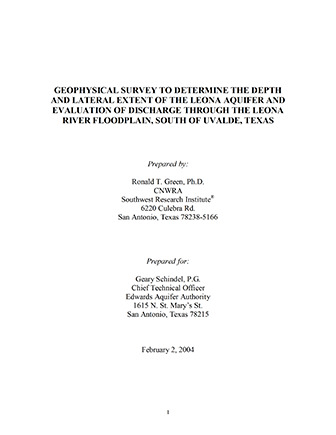Geophysical Survey to Determine the Depth and Lateral Extent of the Leona Aquifer and Evaluation of Discharge Through the Leona River Floodplain, South of Uvalde, Texas

| Summary |
|
The purpose of this study was to evaluate the depth and lateral extent of the Leona Formation. This data was combined with previously determined Leona Aquifer parameters to estimate the amount of water that may be flowing from the Edwards Aquifer in the area of Leona Springs. This information will improve the overall understanding of the Edwards Aquifer hydrologic budgets. The project report concludes that there may be as much as 100,000 acre feet of water leaving the Edwards Aquifer in the vicinity of Leona Springs. Accurate assessment and management of the groundwater resources of the Edwards aquifer require that major sources of water recharge into and discharge from the aquifer be adequately determined. Of interest in this investigation is discharge from the Edwards aquifer as surface water or groundwater flow through the Leona River channel which crosses the aquifer. River channel discharge from the aquifer will only occur in places where the Edwards aquifer is unconfined, no significant thicknesses of impermeable materials separate the river channel from the aquifer, and the static level of groundwater River channels such as those of the Nueces or Frio Rivers (Figure 1) which cross the Edwards aquifer west and east of the Leona River, respectively, do not have sufficient floodplain sediments for a significant fluvial aquifer. Among these river channels, discharge from the Edwards Aquifer is limited to possible surface (or minimal shallow subsurface) water flowing through the river channel. Water recharge into or discharge from the Edwards Aquifer via rivers such as the Frio and Nueces is determined by calculating gains or losses along a reach of the river using stage and flow measurements. The Leona River floodplain differs from those of the Frio and Nueces Rivers. The Leona River floodplain consists of relatively thick (i.e., as great as 70-80 ft) sediments that span a width as great as three miles in places. The sediments, part of the Leona Formation, contain significant sand and gravel paleo-streambed deposits that form the Leona aquifer, which can be a locally prolific aquifer. The potential high capacity for groundwater flow may make the Leona River floodplain a significant area of discharge from the Edwards Aquifer. To determine the quantity of groundwater flow through the Leona aquifer, the depth, lateral extent, hydraulic properties, and groundwater gradient must be known or at least reasonably estimated. A dipole-dipole resistivity survey was conducted in March 2003 to determine the depth and lateral extent of the sand and gravel deposits in the Leona River floodplain. This information was combined with borehole logs, a potentiometric map of groundwater, and the results from a 10-day aquifer test to determine the groundwater flow regime of the Leona Formation aquifer in the Leona River floodplain. The groundwater flow regime was used, in turn, to constrain a conceptual model for groundwater flow through the |
Search for Documents
Advance Search
Explore EAA's Scientific Reports
- All Reports
- Hydrology and Hydrogeology
- History
- Groundwater Recharge, Recharge Zone
- Groundwater Movement
- Geomorphology and Caves
- Weather Modification
- Geology
- Water Use and Conservation
- Geochemistry
- Water Resources Planning and Management
- Floods and Drought
- Water Quality
- Climatology
- Surface Water / Groundwater Relationship
- Biology
- Springs, Groundwater Discharge
- Archaeology
- RZ Protection
- Aquifer Levels
- Remote Sensing
- Precipitation
- Overview Studies
- Modeling
